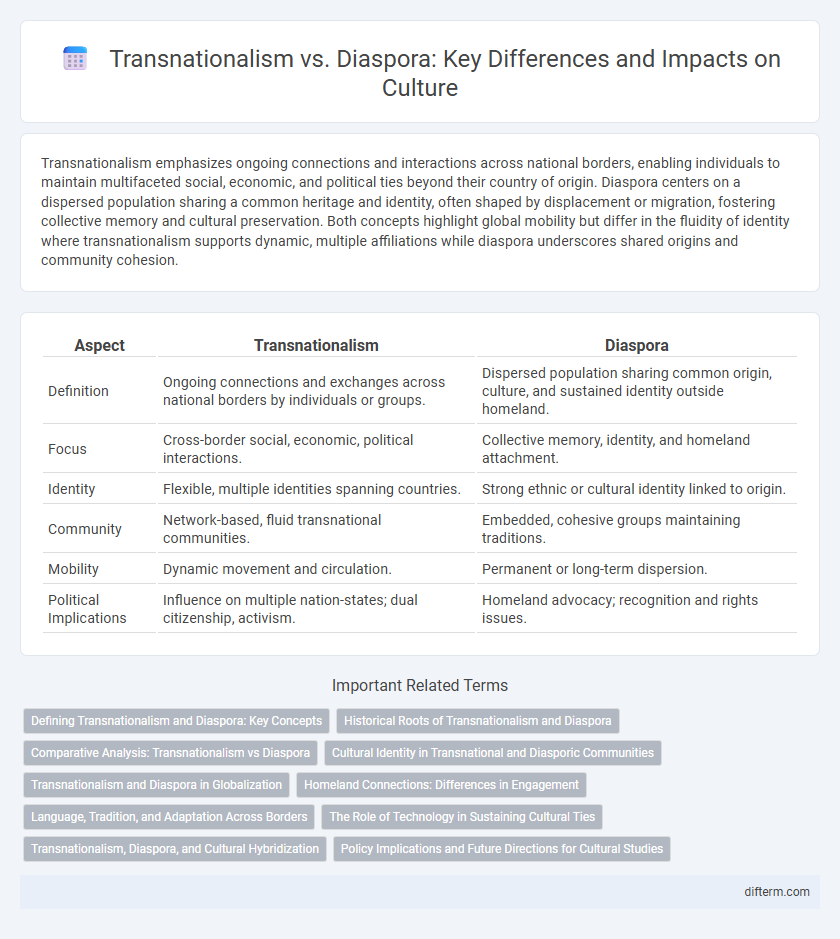Transnationalism emphasizes ongoing connections and interactions across national borders, enabling individuals to maintain multifaceted social, economic, and political ties beyond their country of origin. Diaspora centers on a dispersed population sharing a common heritage and identity, often shaped by displacement or migration, fostering collective memory and cultural preservation. Both concepts highlight global mobility but differ in the fluidity of identity where transnationalism supports dynamic, multiple affiliations while diaspora underscores shared origins and community cohesion.
Table of Comparison
| Aspect | Transnationalism | Diaspora |
|---|---|---|
| Definition | Ongoing connections and exchanges across national borders by individuals or groups. | Dispersed population sharing common origin, culture, and sustained identity outside homeland. |
| Focus | Cross-border social, economic, political interactions. | Collective memory, identity, and homeland attachment. |
| Identity | Flexible, multiple identities spanning countries. | Strong ethnic or cultural identity linked to origin. |
| Community | Network-based, fluid transnational communities. | Embedded, cohesive groups maintaining traditions. |
| Mobility | Dynamic movement and circulation. | Permanent or long-term dispersion. |
| Political Implications | Influence on multiple nation-states; dual citizenship, activism. | Homeland advocacy; recognition and rights issues. |
Defining Transnationalism and Diaspora: Key Concepts
Transnationalism refers to the processes by which migrants create and maintain multiple social relations that link their societies of origin and settlement, emphasizing ongoing connectivity across national borders. Diaspora denotes the dispersion of a population from its original homeland, characterized by shared identity, collective memory, and a long-term commitment to return or solidarity. Both concepts underline cross-border cultural and social dynamics but diverge in their focus on movement patterns versus sustained ethnic identity.
Historical Roots of Transnationalism and Diaspora
Transnationalism originates from historical migration patterns where individuals maintained connections across national borders, often facilitated by colonial trade routes and modern transportation advances. Diaspora reflects communities formed through forced displacement, such as the Jewish and African diasporas, rooted in historical events like slavery, exile, and persecution. Both concepts emphasize sustained cross-border ties but differ in origin, with transnationalism linked to voluntary mobility and diaspora tied to collective trauma and identity preservation.
Comparative Analysis: Transnationalism vs Diaspora
Transnationalism emphasizes ongoing, multidirectional connections between migrants and their homelands, reflecting fluid identities shaped by continuous exchanges across national borders. In contrast, diaspora centers on collective memory, a shared sense of belonging, and long-term attachment to an ancestral homeland often maintained through cultural preservation and political activism. While transnationalism highlights dynamic social practices sustaining transnational networks, diaspora underscores historical experiences of displacement and collective identity formation.
Cultural Identity in Transnational and Diasporic Communities
Transnational and diasporic communities both navigate complex cultural identities shaped by cross-border interactions and historical displacement, respectively. Transnationalism emphasizes ongoing social, economic, and political ties across nation-states, fostering hybrid identities that blend multiple cultural influences. Diaspora communities, rooted in shared ancestry and collective memory, often sustain distinct cultural practices and communal solidarity that reinforce group identity despite geographic dispersion.
Transnationalism and Diaspora in Globalization
Transnationalism in globalization refers to the ongoing connections and social networks that transcend national borders, enabling individuals to maintain active engagement in multiple countries simultaneously. Diaspora communities often embody transnational characteristics, as they preserve cultural identities and participate in economic, political, and social processes across their homelands and host countries. This dynamic interplay emphasizes the fluidity of cultural identities and challenges traditional nation-state boundaries within the globalized world.
Homeland Connections: Differences in Engagement
Transnationalism involves sustained, active connections between migrants and their homeland through frequent communication, remittances, and cultural exchanges, whereas diaspora communities often experience more symbolic or ritualistic ties to their place of origin. Homeland engagement in transnationalism is typically dynamic and ongoing, reflecting everyday social, economic, and political involvement. Diaspora connections tend to emphasize collective memory, identity preservation, and occasional homeland visits or festivals.
Language, Tradition, and Adaptation Across Borders
Transnationalism emphasizes the continuous exchange and adaptation of language and traditions across borders, fostering dynamic cultural practices that evolve through sustained connections between host and home countries. Diaspora communities often maintain heritage languages and rituals to preserve identity, yet adaptation occurs as they integrate elements from the host culture, creating hybrid cultural expressions. Both frameworks highlight the balance between cultural retention and transformation, where language shifts and traditional innovations reflect ongoing negotiation of belonging in multiple social landscapes.
The Role of Technology in Sustaining Cultural Ties
Technology plays a crucial role in sustaining cultural ties within transnationalism and diaspora by enabling instant communication and virtual community-building across borders. Social media platforms, messaging apps, and video conferencing tools help individuals maintain connections to their heritage, participate in cultural events, and share traditions despite geographical distances. Digital archives and online cultural repositories preserve languages, rituals, and histories, reinforcing identity and cultural continuity among dispersed populations.
Transnationalism, Diaspora, and Cultural Hybridization
Transnationalism refers to the process by which immigrants maintain active connections across national borders, fostering continuous exchange of cultural practices, ideas, and identities. Diaspora describes communities dispersed from their original homeland, often preserving collective memory and cultural heritage despite geographical separation. Cultural hybridization emerges through the interaction of transnational networks and diasporic identities, resulting in the creation of new, syncretic cultural forms that blend elements from multiple cultural origins.
Policy Implications and Future Directions for Cultural Studies
Transnationalism emphasizes fluid, cross-border cultural exchanges that challenge fixed national identities, urging policymakers to adopt inclusive frameworks accommodating hybrid identities. Diaspora studies highlight the ongoing ties of dispersed communities to their homelands, prompting cultural policies to support diasporic heritage preservation and transnational social networks. Future directions in cultural studies call for integrating both transnationalism and diaspora perspectives to address the complexities of identity, migration, and cultural belonging in globalized societies.
transnationalism vs diaspora Infographic

 difterm.com
difterm.com